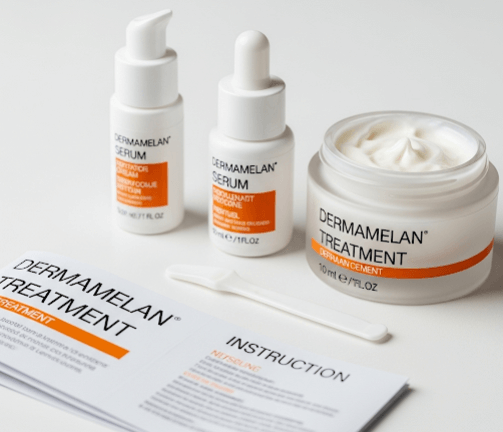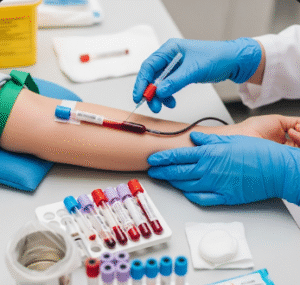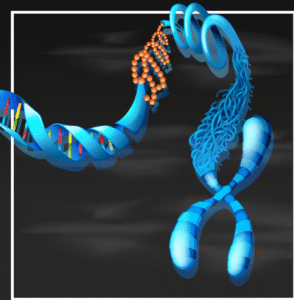What it is
→ Dermamelan treatment is a professional depigmentation program specifically designed to treat moderate to severe hyperpigmentation, including stubborn cases of melasma, sun-induced pigmentation, post-inflammatory hyperpigmentation (PIH), freckles, and age spots.
→ It is considered the medical-grade version of Cosmelan, with a stronger formula and more intensive action.
→ Dermamelan works by combining chemical peeling, melanin suppression, and skin regeneration. Its active ingredients often include kojic acid, azelaic acid, arbutin, retinoids, phytic acid, and tranexamic acid.
→ In Korea, Dermamelan is a popular choice in dermatology clinics for patients with resistant pigmentation or those who did not respond adequately to other treatments.
Why it’s done
→ Dermamelan is performed to:
- Treat stubborn melasma (hormonal or chronic).
- Lighten freckles, sunspots, and age-related pigmentation.
- Reduce acne-related dark marks (PIH).
- Restore even skin tone and brightness.
- Prevent recurrence by inhibiting melanin production.
- Improve skin texture through controlled exfoliation.
→ It is considered one of the most powerful pigmentation solutions available worldwide, especially for severe or relapsing cases.
Alternatives
→ Alternatives to Dermamelan include:
- Cosmelan peel → similar, but milder, suitable for moderate pigmentation.
- Pigmentation cocktail peels → customized blends for gradual brightening.
- Laser toning (Q-switched Nd:YAG) → for melasma and PIH.
- Fractional lasers or IPL → target sun damage and uneven tone.
- Topical creams → hydroquinone, retinoids, vitamin C.
- Tranexamic acid therapy → oral or topical, often combined with other treatments.
→ While these are effective, Dermamelan is often chosen for stubborn pigmentation cases where other therapies fail.
Preparation
→ Before Dermamelan treatment, patients should:
- Avoid sun exposure and tanning for at least 2–4 weeks.
- Stop harsh skincare (retinoids, exfoliants, AHAs/BHAs) 5–7 days before.
- Hydrate skin with moisturizers to prepare barrier function.
- Use sunscreen daily leading up to the treatment.
- Discuss medical history (eczema, rosacea, sensitive skin, keloids) with the dermatologist.
- Patch test may be performed for safety.
→ Korean dermatologists often provide a pre-treatment regimen with mild brightening or hydrating creams.
How it’s Done
Dermamelan involves a two-phase protocol:
Phase 1 – In-clinic application
- Skin is thoroughly cleansed and degreased.
- The Dermamelan mask is applied evenly to the face (or targeted areas).
- The mask contains concentrated depigmenting agents and must remain for 8–12 hours, depending on skin type and severity.
- Patients remove the mask at home under dermatologist instructions.
Phase 2 – Home maintenance
- Patients continue treatment with Dermamelan home-care products (creams containing melanin inhibitors, soothing creams, and sunscreen).
- This phase lasts for several months and is crucial for long-term results.
→ A complete Dermamelan program usually lasts 3–6 months, with progressive improvement.
Recovery
→ Recovery after Dermamelan involves an adjustment period:
- Days 1–3 → redness, tightness, mild swelling.
- Days 3–7 → peeling, flaking, and dryness appear.
- Week 2 onward → visible brightening, fading of pigmentation.
- 1–3 months → significant improvement in melasma and dark spots.
- 3–6 months → maximum results with even skin tone and reduced recurrence.
→ Aftercare includes:
- Daily use of soothing creams to reduce irritation.
- Strict sun protection (SPF 50+), even indoors.
- Avoiding heat, sweating, or harsh skincare during peeling phase.
- Not picking or peeling flaking skin.
→ Most patients can continue normal activities, but peeling may be noticeable for the first week.
Complications
→ Dermamelan is safe when done professionally, but possible side effects include:
- Redness, dryness, and peeling (expected in early weeks).
- Tingling or mild burning sensations.
- Post-inflammatory hyperpigmentation (PIH) if sun exposure is not avoided.
- Hypopigmentation (rare, usually if overused).
- Temporary acne breakouts or purging.
→ Risks are minimized with dermatologist supervision and strict adherence to aftercare.
Treatment options in Korea
→ Korea offers Dermamelan treatment at advanced dermatology centers, where pigmentation care is a specialty:
- Medical-grade protocols → Dermamelan is performed only under dermatologist supervision.
- Customized regimens → Korean dermatologists often combine Dermamelan with laser toning, whitening serums, or oral tranexamic acid for resistant melasma.
- Post-care kits → include hydrating and soothing products alongside Dermamelan cream for at-home use.
- Pigmentation expertise → Korean clinics are globally recognized for treating melasma in Asian skin, minimizing risk of rebound pigmentation.
- Holistic approach → focus on both clearing existing pigment and preventing recurrence.
- Medical tourism → international patients receive English-language support, long-term plans, and telemedicine follow-ups.
→ With powerful formulations, skilled dermatologists, and world-class aftercare, Korea is one of the best destinations for Dermamelan treatment.













